Stories
Colin Cole
1931-1987

Colin Cole was one of New Zealand’s leading designers from the late 1950s through to the 1980s. He aspired to make women look their best, while pushing at the boundaries of convention with his striking yet feminine designs.
Born in Rotorua in 1931, Colin was the eldest of the Cole children. He had three younger siblings – Betty, Michael and Carolyn. His father, Howard Cole, worked as a farmer, and his mother, Whylma, was a trained pattern maker and seamstress. Both of his were parents profoundly deaf. Howard’s mother spent a lot of time with the children when they were young to ensure there was always someone around talking to them.

Colin, age 5, and his younger sister Betty on the family farm in Rotorua. Image © Carolyn McCondach
To help supplement the family income, Whylma made wedding dresses for the local Māori women. Many of her clients didn't have much money and sometimes payment was in the form of a bag of kumara and an invitation for the family to attend the wedding. From a young age Colin was introduced to and accepted into the Māori community and it was these relationships formed in his early years which created a deep and continuing bond between himself and his Māori friends.
Colin always demonstrated a flair for design – especially when it came to appearance and presentation. He liked to dress up to look his best and would pick flowers from the garden to decorate the dining table. It was clear that his future job at the local Rotorua post office would not work out. Colin moved to Auckland with his heart set on a career in window dressing. However, he quickly realised he did not have the experience needed for window dressing and decided to pursue a career in what he knew best – dress making and design.
To gain experience in the fashion industry, Colin completed a pattern making and garment design apprenticeship at Classic Manufacturing. Not long after completing the apprenticeship he decided to venture out on his own and start his own clothing line. His first foray was not a success so he took up a position at children's wear manufacturer, Poppetwear.
In 1958, Colin met his future wife Mairehau. He also made his second attempt to start his own business – opening a couture boutique on Karangahape Road. The flagship store flourished, helped by its location in the area which was known as a fashion and textile hub. Rendall's, Barker & Pollock, La Gonda, Leo O'Malley and George Courts were just some of the fashion stores located on or near K Road.
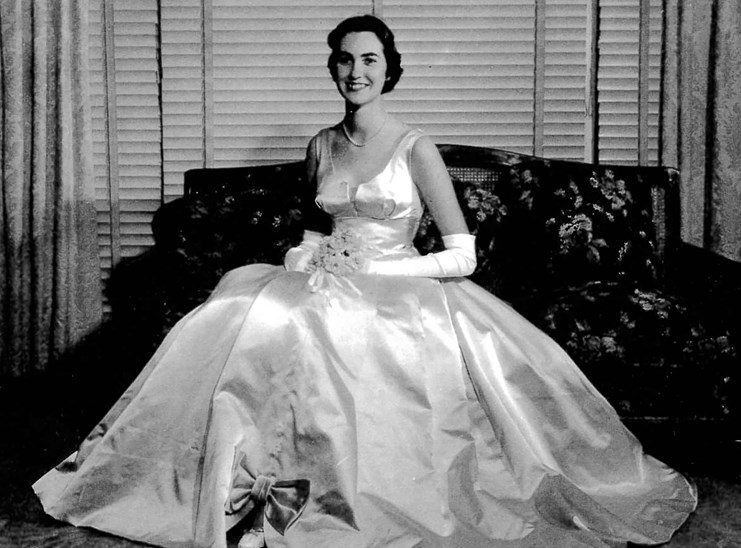
In the 1960s, Colin Cole specialised in large, opulent dresses such as this debutant ball gown. Made from fine silk sateen, the dress has a tulle underskirt to add volume. Image © Colin Cole Estate.
Colin specialised in bespoke gowns, evening dresses, debutante wear and smart daywear, mainly working with heavy silks and satins. He had been inspired to become a designer by Christian Dior's 'New Look' and this was reflected in his desire to make women look and feel beautiful. He used quality fabric to ensure his garments would last and become a staple in a woman’s wardrobe. His garments were almost always finished with self fabric covered buttons and hand-stitched detailing, including a hand worked label with his name and a rose.
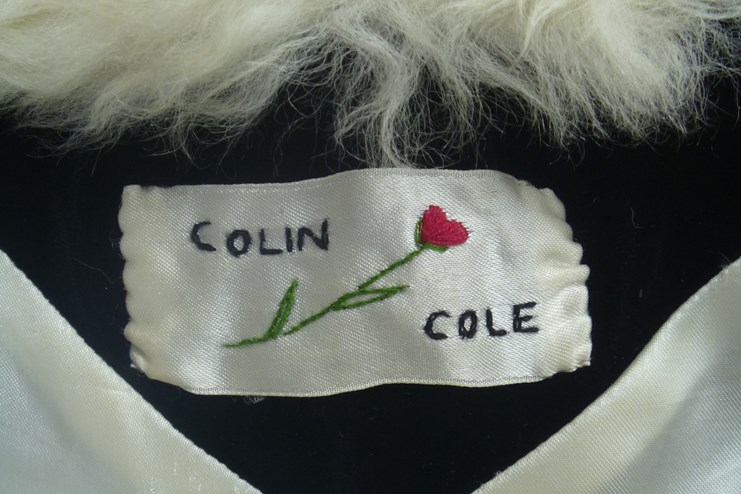
A hand-sewn label from the 1960s.
Three years later, Colin relocated his boutique to 396 Queen Street to accommodate his growing clientele. In the late 1960s he moved to Parnell where he opened a small salon.
His final move was to 283 Parnell Road, where he opened his boutique, The Establishment, in the late 1970s. Here he worked alongside John Kite and house model/professional muse, Susanna Williams. John Kite began as an assistant cutter/patternmaker and progressed to supervise/ co-ordinate the daily running of the workroom.
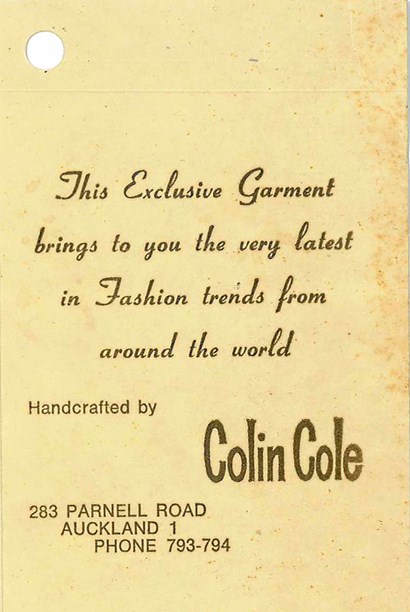
Colin Cole garment swing tag from the late 1970s. Image © Colin Cole Estate.
It was at this time that Colin had a brief foray into menswear design. He was also involved behind the scenes in the many fashion parades which were popular at this time, including fundraising events for causes such as the Child Cancer Foundation.
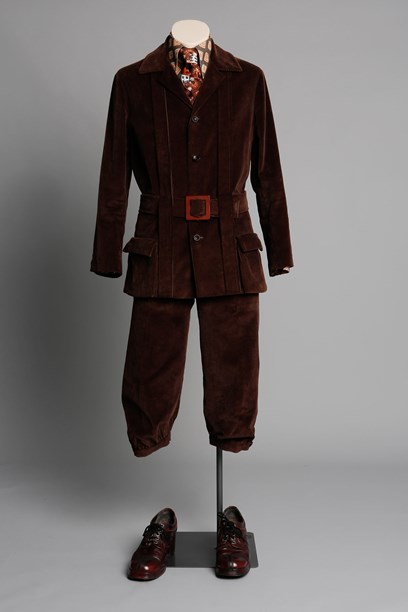
Colin Cole knickerbocker suit from the early 1970s. Image by NZFM, licensed under a Creative Commons Attribution-NonCommercial-ShareAlike 3.0 New Zealand License.
Colin’s caring nature was evident in how he treated his clients. Carolyn, Colin’s youngest sister, remembers when a loyal customer visited the salon for a fitting, complaining that she had become "as large as a barrel". Not missing a beat, Colin said, "Mrs G, I am going to make you the best looking barrel in Auckland."
He received countless letters and notes from thankful customers and celebrities, but there was one complaint –an outpouring of wrath from a client in 1964 was discovered after his death. The irate woman urged him to put the dress she’d bought back into stock and sell it. Everything about the garment was disagreeable to her. "Please let me know what you can do with it ... I never want to see it again," she wrote (Woman's Weekly, Claire Parker, July 1987).
One suspects that Colin would have taken this in his stride, as he had plenty of experience dealing with querulous women. His eldest daughter, Virginia Cole, was the first of eight daughters. Apparently Colin was more than happy to let them play dress-ups and they were regularly seen out and about in his latest designs.

Colin and Mairehau with their daughters, granddaughters and a family friend in the 1970s. Image © Colin Cole Estate.
Colin Cole's designs were regularly reported on in the media – particularly his bridal wear and his trend reports for current designs. In a New Zealand Herald article (13 September 1983), Colin describes his approach to clothing design and customer relations: "Often his hardest job is persuading a woman that she can turn heads just as she is. 'Every woman who comes in here apologises for her body, my job is to make them look wonderful.' If after the 12 hours of work which goes into the average garment, a woman walks out on cloud nine, he is pleased. To Colin Cole, designing clothes is an act of love." It is no wonder that he was able to build up a large and loyal customer base.
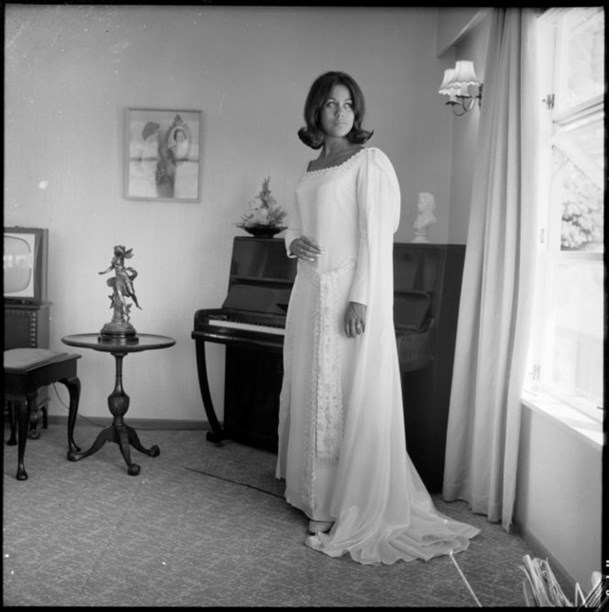
Kiri Te Kanawa wearing a Colin Cole concert gown. Photo by an Evening Post staff photographer, courtesy of Alexander Turnbull Library, Wellington, EP/1966/0479-F.
Colin’s untimely death in 1987 at the age of 57 was a shock to all his clients and the fashion community. He was closely associated with the Anglican community and his funeral was held at St Paul's Church on Symond St. His service was described as a "beautiful experience" with many of the 350 who attended wearing a colourful array of flowing gowns and bright suits.
"The New Zealand fashion industry lost its brightest star ... He reigned as sage and oracle of the fashion industry for almost 30 years," (Woman's Weekly, Claire Parker, July 1987).
Text by Juliet Fortescue. Banner photo by Clifton Firth, courtesy of Auckland Libraries Heritage Collections, ID 34-70.
Published August 2014.